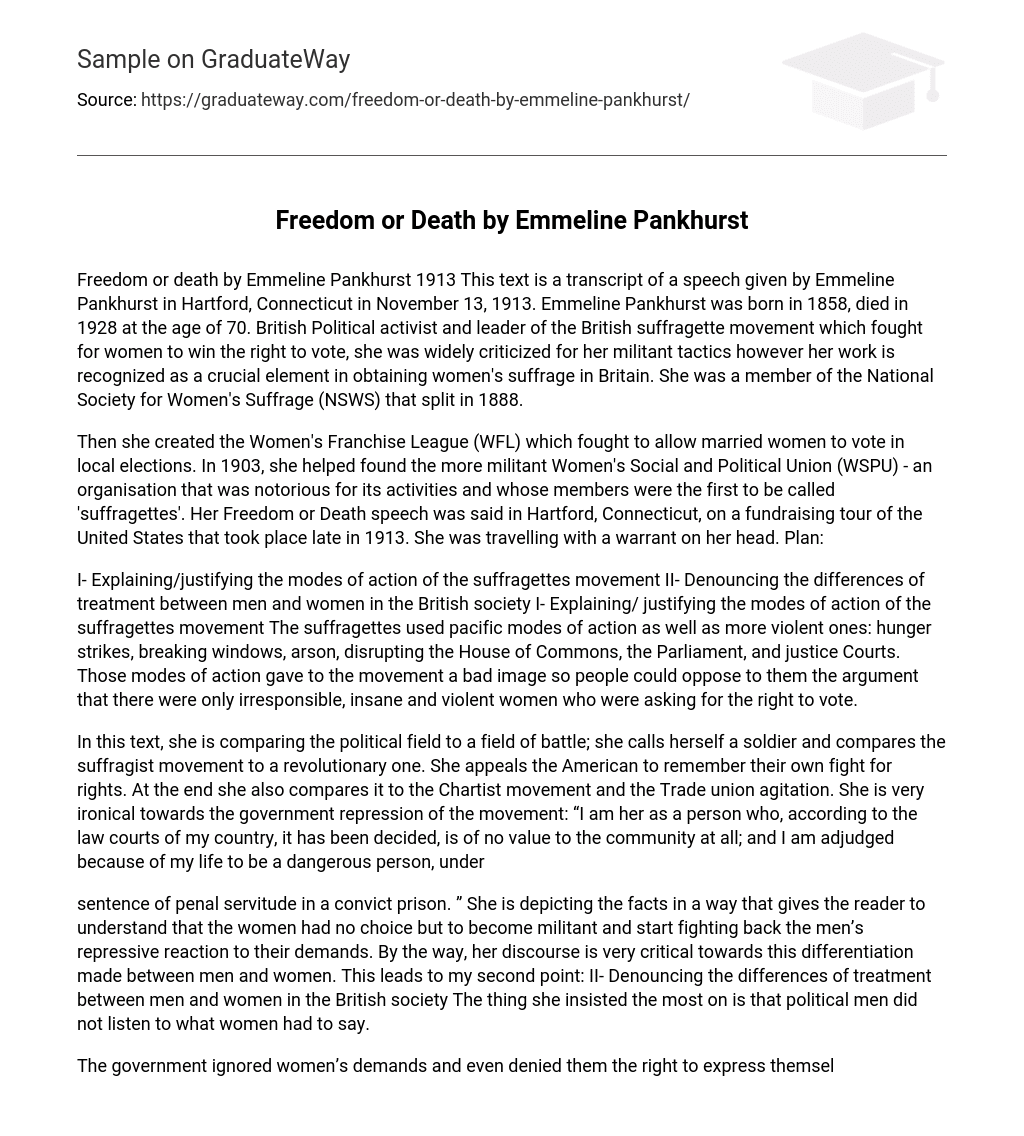Freedom or death by Emmeline Pankhurst 1913 This text is a transcript of a speech given by Emmeline Pankhurst in Hartford, Connecticut in November 13, 1913. Emmeline Pankhurst was born in 1858, died in 1928 at the age of 70. British Political activist and leader of the British suffragette movement which fought for women to win the right to vote, she was widely criticized for her militant tactics however her work is recognized as a crucial element in obtaining women’s suffrage in Britain. She was a member of the National Society for Women’s Suffrage (NSWS) that split in 1888.
Then she created the Women’s Franchise League (WFL) which fought to allow married women to vote in local elections. In 1903, she helped found the more militant Women’s Social and Political Union (WSPU) – an organisation that was notorious for its activities and whose members were the first to be called ‘suffragettes’. Her Freedom or Death speech was said in Hartford, Connecticut, on a fundraising tour of the United States that took place late in 1913. She was travelling with a warrant on her head. Plan:
I- Explaining/justifying the modes of action of the suffragettes movement II- Denouncing the differences of treatment between men and women in the British society I- Explaining/ justifying the modes of action of the suffragettes movement The suffragettes used pacific modes of action as well as more violent ones: hunger strikes, breaking windows, arson, disrupting the House of Commons, the Parliament, and justice Courts. Those modes of action gave to the movement a bad image so people could oppose to them the argument that there were only irresponsible, insane and violent women who were asking for the right to vote.
In this text, she is comparing the political field to a field of battle; she calls herself a soldier and compares the suffragist movement to a revolutionary one. She appeals the American to remember their own fight for rights. At the end she also compares it to the Chartist movement and the Trade union agitation. She is very ironical towards the government repression of the movement: “I am her as a person who, according to the law courts of my country, it has been decided, is of no value to the community at all; and I am adjudged because of my life to be a dangerous person, under
sentence of penal servitude in a convict prison. ” She is depicting the facts in a way that gives the reader to understand that the women had no choice but to become militant and start fighting back the men’s repressive reaction to their demands. By the way, her discourse is very critical towards this differentiation made between men and women. This leads to my second point: II- Denouncing the differences of treatment between men and women in the British society The thing she insisted the most on is that political men did not listen to what women had to say.
The government ignored women’s demands and even denied them the right to express themselves in front of the Parliament. Secondly she demonstrated that women were repressed even more severely than men. They were sent to prison on any motives, and the government passed laws to allow that. But what she really demonstrate through those facts is that women are stronger than then thought because for the first time they needed to make new laws to react against a group of activists.
Conclusion She did not make this speech to campaign for the right to vote for women. She wanted to prove that women are equals to men when it comes about defending their rights. She denounces the reactions of the British government and accuses them to be the cause of the extreme measures taken by the militants of the suffragette’s movement This text shows the birth of the feminist ideas that men and women are equals and that they should be treated as such in every domains.
The 1918 Representation of the People Act was the start of female suffrage in Great Britain. The bill was passed by an overwhelming majority in the House of Commons (385 for to 55 against) – an element of support that surprised the Suffragettes and other suffragist movements. The 1918 Representation of the People Act gave women of property over the age of 30 the right to vote – not all women, therefore, could vote – but it was a major start.





